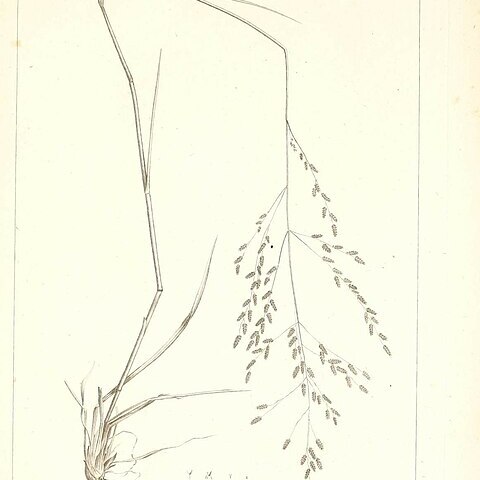Perennial. Culms loosely tufted, erect or geniculate at base, 15–100 cm tall, ca. 4 mm in diam., 4–8-noded. Leaf sheaths glabrous but pilose along summit; ligules a ciliolate membrane, 0.2–0.3 mm; leaf blades flat or involute, 4–17 × 0.2–0.4 cm, adaxial surface scabrous, near base pilose, abaxial surface glabrous. Panicle open, 5–20(–25) × 2–15 cm; branches one to several per node. Spikelets plumbeous and purplish, narrowly oblong, 5–15(–25) × 1.5–2.5 mm, 8–40-flowered, pedicels 0.5–5(–15) mm; rachilla persistent. Glumes 1-veined, 1–2.3 mm; lower glume ovate, 1–1.3 mm, apex acute, upper glume narrowly ovate, 1.3–2.3 mm, apex acuminate. Lemmas broad ovate, 1.8–2.2 mm, apex acute, lower lemma 2–2.2 mm, deciduous with palea. Palea loosely ciliate along keel, 1.6–1.8 mm. Stamens 3; anthers 0.7–0.9 mm. Caryopsis ca. 1 mm. Fl. and fr. summer and autumn. 2n = 40.
Spikelets 3–20 × 1.5–2.5 mm, narrowly oblong, rarely falcate, laterally compressed, 6–50-flowered, the florets disarticulating from below upwards, the rhachilla persistent; glumes subequal, 0.8–1.7 mm long, reaching about 2/3 the way along the adjacent lemmas, keeled, lanceolate-elliptic in profile, glabrous, acute at the apex; lemmas 1.6–2.4 mm long, keeled, ovate in profile, membranous with distinct lateral nerves, diverging from the rhachilla at c. 45°, those in opposite rows not imbricate, the rhachilla visible between them, yellowish to grey-green or dark green, often tinged with purple, minutely asperulous, acute or subacute at the apex; palea deciduous with or soon after the lemma, glabrous on the flanks, the keels slender, wingless, scaberulous; anthers 3, 0.5–1 mm long.
Caespitose perennial without rhizomes or stolons; culms slender, up to 100 cm tall, erect, unbranched, glabrous at the nodes, eglandular; basal leaf sheaths glabrous, chartaceous, usually compressed, eglandular, persistent; ligule a line of hairs; leaf laminas 15–30 cm × 2–4 mm, linear, flat or involute, glabrous or ciliate below, eglandular.
Panicle 4–40 cm long, ovate or oblong, open, the spikelets loosely contracted about the primary branches on pedicels 0.5–2.5 mm long, the primary branches not in whorls, terminating in a fertile spikelet, glabrous in the axils, eglandular.
Caryopsis c. 0.7 mm long, elliptic.

